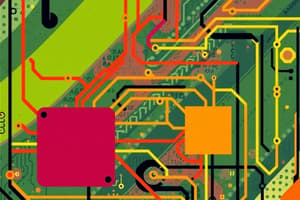Podcast
Questions and Answers
In a series circuit, what does 'series' mean?
In a series circuit, what does 'series' mean?
- Components are connected randomly
- Components are connected end-to-end (correct)
- Components are connected in a loop
- Components are connected side by side
What is a characteristic of current flow in a series circuit?
What is a characteristic of current flow in a series circuit?
- Multiple paths for the current to flow
- Current flowing in opposite directions
- One path for the current to flow (correct)
- Different currents at different points
How does the current flow between components in a series circuit?
How does the current flow between components in a series circuit?
- It combines and flows in one direction (correct)
- It splits and goes in different directions
- It disappears and reappears
- It flows in opposite directions
What does 'parallel' mean in a parallel circuit?
What does 'parallel' mean in a parallel circuit?
How many paths for current flow are there in a parallel circuit?
How many paths for current flow are there in a parallel circuit?
What is the measurement unit of voltage?
What is the measurement unit of voltage?
What is the most common voltage supplied by batteries?
What is the most common voltage supplied by batteries?
How is a voltmeter connected in a circuit to measure voltage?
How is a voltmeter connected in a circuit to measure voltage?
What does 'mains voltage' refer to?
What does 'mains voltage' refer to?
What is the range of mains voltage in most countries?
What is the range of mains voltage in most countries?
Flashcards are hidden until you start studying
Study Notes
Series Circuit
- Components are connected end-to-end, forming a single path for current to flow.
- Current is the same throughout the circuit.
- All current flowing out of one component flows into the next component.
Parallel Circuit
- Multiple paths (branches) for current to flow.
- Current can flow through different paths.
Voltage
- Linked to electrical energy in a circuit.
- Measured in volts (V).
- Related to energy supplied to a circuit by a cell, battery, or power supply.
- Not the same as energy.
- Typical voltage supplies:
- Cells: 1.5 V.
- Batteries: 6 V, 9 V, 12 V (2 or more cells connected in series).
- Mains voltage: 220-240 V (most countries), 110-120 V (some countries).
Measuring Voltage
- Uses a voltmeter.
- Connected differently to an ammeter.
- An ammeter measures current, connecting in series with a component.
Studying That Suits You
Use AI to generate personalized quizzes and flashcards to suit your learning preferences.




